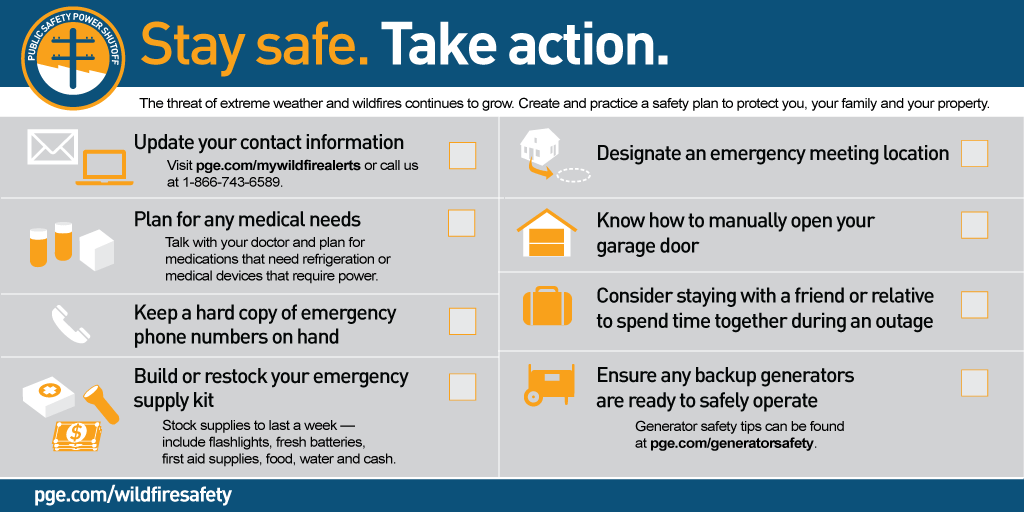
Wildfire season is here and Marin County residents need to be prepared for prolonged power outages related to PG&E’s efforts to reduce wildfire risks. Having key items, such as a working flashlight and 3-day supply of water and food, is one important component of a preparedness plan and can make it easier to cope with power outages. But residents also need to prepare and plan to evacuate and to shelter-in-place. Visit readymarin.org for resources to prepare yourself, your family & friends, and your neighborhood for prolonged power outages.
If you are Marin County resident with a disability or access and functional needs (AFN), review FEMA’s Preparing Makes Sense For People With Disabilities, Others with Access and Functional Needs and the Whole Community. Ready.gov has also developed preparedness resources specific for individuals with access and functional needs.
Preparing for Extended Power Outages in Marin County
What is a Public Safety Power Shutoff (PSPS)?
Most Marin County residents live in elevated (Tier 2) or extreme (Tier 3) fire threat areas. Pacific Gas and Electric Company (PG&E) is expanding its Community Wildfire Safety Program. This includes turning off electric power for safety (Public Safety Power Shutoff) when extreme fire danger conditions are forecasted. Learn more about Public Safety Power Shutoffs at prepareforpowerdown.com.
When will PG&E activate the PSPS? For how long?
PG&E may activate a Public Safety Power Shutoff if extreme fire danger conditions are forecasted to help reduce the likelihood of an ignition. These include, but are not limited to:
- A Red Flag Warning declared by the National Weather Service
- Low humidity levels, generally below 20 percent
- Forecasted sustained winds generally above 25 mph
Marin County residents need to prepare for at least 5 days without electricity.
PG&E Power Outage Map
What should I do to prepare?
Ask yourself these 4 questions:
- How will I receive emergency alerts and warnings? When possible, PG&E will notify customers of a possible Public Safety Power Shutoff. Register for PG&E’s Wildfire Safety Shutoff Alerts so PG&E can contact you when the power needs to be shut off for safety. Also, register for emergency alerts at both Alert Marin and Nixle to receive notifications about other emergencies that may effect your safety Learn more about Marin County’s Emergency Alert and Warning Tools.
- What is my shelter plan? Collect items you’ll need to evacuate using Ready Marin’s Grab & Go Checklist and prepare to shelter-in-place for at least 5 days using Ready Marin’s Build a Kit Checklist.
- What is my evacuation route? If you need Electricity and Battery-Dependent Assistive Technology and Medical Devices, especially life support equipment (e.g., ventilators, apnea monitors, dialysis machines), you should consider staying with friends or family during a prolonged power outage.
- What is my family/household communication plan? Build a support team of people who will help you in an emergency if necessary. The real first responders in an emergency are often your neighbors, friends and co-workers. If you complete your Family Emergency Communication Plan online at ready.gov/make-a-plan, you can print it onto a wallet-sized card and share with your support team.
What if I need Electricity and Battery-Dependent Assistive Technology and Medical Devices?
- Update your contact information with PG&E at pge.com/mywildfirealerts or call 1-866-743-6589.
- Follow FEMA’s recommendations in its Power Outage Information Sheet
- Review and update the American with Disabilities Act’s Emergency Power Planning Checklist every 6 months
Special Considerations
- Create a back-up power plan, including getting back-up batteries for durable medical equipment (DME) [some batteries require a prescription].
- Teach your neighbors and caregivers how to use your backup systems and operate your equipment.
- Make a plan for how to recharge batteries when the electricity is out.
- Make sure use of a generator is appropriate, safe and realistic for where you live. Incorrect generator use can lead to carbon monoxide (CO) poisoning.
Additional Resources
Marin County Health and Human Services. Preparing for Extended Power Outages.
BC Association for Individualized Technology and Supports for People with Disabilities (BCITS). Self-Help Guide • Back-up Power for Ventilators.
Centers for Disease Control and Prevention. Power Outages.
Centers for Medicare and Medicaid Services. Medicare coverage in disasters and emergencies.

